Fast-tracked Immunotherapies Offer Hope for Aggressive Brain Cancers
Patients with aggressive, high-grade malignant brain cancers, like glioblastoma multiforme (GBM) and anaplastic astrocytoma (AA), have a poor prognosis with no known curative treatment using standard resection, radiation and chemotherapy approaches. With this bleak clinical outlook, the U.S. Food and Drug Administration (FDA) has fast-tracked clinical development of several new therapies.1 According to Brad Zacharia, MD, MS, assistant professor of neurosurgery, Penn State Neuroscience Institute, and co-director of neuro-oncology, Penn State Cancer Institute, “With aggressive tumors like GBM and AA, neuro-oncologists worldwide are exploring biological and immune-targeted therapies, to identify more effective treatments. We (Penn State Health Milton S. Hershey Medical Center) are an investigational site for a number of clinical trials for these types of cancers.”
One of the most promising immunotherapies under investigation is a dendritic cell (DC)-based vaccine called ICT- 107 in phase III development for treatment of GBM (ImmunoCellular Therapeutics, Ltd.). ICT-107 targets multiple tumor-associated antigens for patients with newly diagnosed GBM tumors that are positive for human leucocyte antigen A2 (HLA-A2+), one of the most frequent HLA class I specificities. In this trial, white blood cells harvested from patients with qualifying tumors are exposed to six synthetic peptides developed from tumor-associated antigens, then incubated and allowed to develop into antigen-presenting dendritic cells. This dendritic cell vaccine is then reinfused into the patient, triggering a tumor-specific immune response from cytotoxic T lymphocytes. Findings from a phase I trial were promising.2
Dr. Zacharia adds, “In the phase III trial for ICT-107, patients with a new diagnosis of GBM, following tumor resection, may receive standard-of-care chemo-radiation paired with ICT-107 or chemo-radiation plus placebo.” ICT-107 is administered intra-dermally each week for the first month, then monthly for the first year. Dr. Zacharia adds, “This is one of the few phase III trials being conducted in patients with newly diagnosed GBM. It offers hope for an effective treatment earlier in the disease process, before the tumor recurs.”
A second promising pipeline candidate is Toca-511/FC (Tocagen, Inc.) for the treatment of new or recurrent GBM or AA. Toca-511/FC comprises a two-step treatment regimen following tumor resection. The first component, Toca-511, utilizes retroviral replicating vectors (RRVs) injected at the time of surgery designed to selectively deliver therapeutic genes to dividing cancer cells, which then spread to neighboring cancer cells. In this case, the Toca-511 RRV infects remaining cancer cells and causes them to express cytosine deaminase (CD). The patient then receives the second treatment component, the antibiotic 5-fluorocytosine (5-FC). In infected cells, CD converts 5-FC to the anti-cancer drug 5-fluorouracil (5-FU), hopefully leading to selective tumor cell death. Recruitment in trials of Toca-511/FC for newly diagnosed GBM (Phase 1: NCT02598011) or recurrent GBM (Phase II/III: NCT02414165) is expected to begin sometime in 2016.
Dr. Zacharia adds, “Because not all patients will qualify for every trial, we believe participating in a wide variety of trials is most beneficial to our patients. With several trials ongoing at any one time, each with distinct eligibility criteria, a patient is more likely to be able to participate and possibly benefit from a new therapy.”

Brad E. Zacharia, MD, MS
Associate Professor of Neurosurgery and Otolaryngology
Co-director, Neuro-Oncology Program
Director, Brain Tumor and Skull Base Surgery, Penn State Health Milton S. Hershey Medical Center
Phone: 717-531-4177
Email: bzacharia@pennstatehealth.psu.edu
Fellowship: Neurosurgical Oncology, Memorial Sloan Kettering Cancer Center, New York
Residency: Neurological Surgery, New York Presbyterian Hospital – Columbia University, New York
Medical School: Columbia University College of Physicians and Surgeons, New York
Connect with Brad E. Zacharia, MD, MS, on Doximity
References
- Xiu J, Piccioni D, Juarez T, et al. 2016. Multi-platform molecular profiling of a large cohort of glioblastomas reveals potential therapeutic strategies. Oncotarget. Feb 25.
- Phuphanich S, Wheeler CJ, Rudnick JD, et al. 2013. Phase I trial of a multi-epitope-pulsed dendritic cell vaccine for patients with newly diagnosed glioblastoma. Cancer Immunol Immunother. Jan;62(1):125-35.

